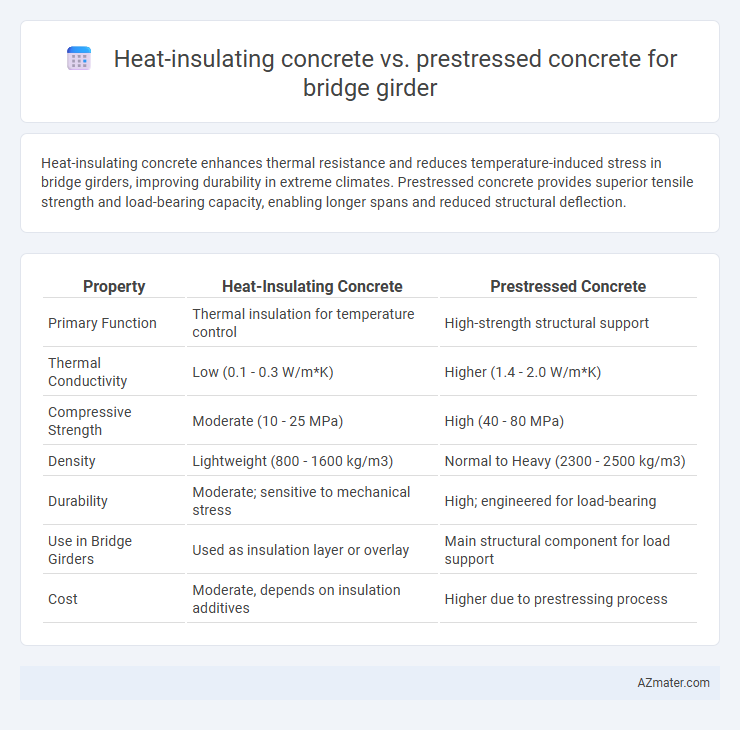Heat-insulating concrete enhances thermal resistance and reduces temperature-induced stress in bridge girders, improving durability in extreme climates. Prestressed concrete provides superior tensile strength and load-bearing capacity, enabling longer spans and reduced structural deflection.
Table of Comparison
| Property | Heat-Insulating Concrete | Prestressed Concrete |
|---|---|---|
| Primary Function | Thermal insulation for temperature control | High-strength structural support |
| Thermal Conductivity | Low (0.1 - 0.3 W/m*K) | Higher (1.4 - 2.0 W/m*K) |
| Compressive Strength | Moderate (10 - 25 MPa) | High (40 - 80 MPa) |
| Density | Lightweight (800 - 1600 kg/m3) | Normal to Heavy (2300 - 2500 kg/m3) |
| Durability | Moderate; sensitive to mechanical stress | High; engineered for load-bearing |
| Use in Bridge Girders | Used as insulation layer or overlay | Main structural component for load support |
| Cost | Moderate, depends on insulation additives | Higher due to prestressing process |
Introduction to Bridge Girder Concrete Types
Heat-insulating concrete for bridge girders enhances thermal resistance, reducing temperature-induced expansion and contraction that can cause structural stress and deterioration. Prestressed concrete incorporates tensioned steel tendons to improve load-bearing capacity and control cracking under high tensile stresses common in bridge applications. Selecting the appropriate bridge girder concrete type depends on environmental conditions, load requirements, and longevity considerations to ensure structural integrity and durability.
Overview of Heat-insulating Concrete
Heat-insulating concrete for bridge girders offers superior thermal resistance, reducing temperature-induced stress and enhancing structural durability in extreme climates. Its composition includes lightweight aggregates and insulating materials that lower thermal conductivity compared to conventional prestressed concrete. This type of concrete helps maintain structural integrity by minimizing thermal expansion and contraction, leading to longer service life and reduced maintenance costs.
Overview of Prestressed Concrete
Prestressed concrete for bridge girders involves pre-tensioning or post-tensioning high-strength steel tendons within the concrete to enhance load-bearing capacity and reduce tensile stresses. This method improves structural efficiency by minimizing cracking and deflection compared to conventional reinforced concrete, making it ideal for long-span bridges. Its durability and resistance to environmental factors contribute to longer service life and reduced maintenance costs.
Material Composition and Properties Comparison
Heat-insulating concrete for bridge girders incorporates lightweight aggregates such as expanded perlite or vermiculite, mixed with cement and insulating additives to enhance thermal resistance and reduce heat transfer. Prestressed concrete utilizes high-strength steel tendons tensioned before or after casting, combined with standard aggregates and cementitious materials, resulting in superior tensile strength and enhanced load-bearing capacity. While heat-insulating concrete offers improved thermal performance and fire resistance, prestressed concrete provides greater structural durability and resistance to tensile stresses, making each suitable for specific engineering requirements in bridge construction.
Structural Performance and Load-Bearing Capacity
Heat-insulating concrete for bridge girders enhances thermal resistance while maintaining adequate compressive strength, resulting in improved durability under temperature fluctuations. Prestressed concrete girders exhibit superior structural performance through pre-tensioning, which significantly increases load-bearing capacity and reduces cracking under service loads. Comparative studies show prestressed concrete offers higher flexural strength and stiffness, making it more suitable for long-span bridges requiring greater load management.
Thermal Performance and Energy Efficiency
Heat-insulating concrete enhances thermal performance in bridge girders by reducing heat transfer, thereby minimizing temperature-induced stresses and improving overall durability. Prestressed concrete, while primarily designed for structural efficiency, offers limited thermal insulation but effectively controls cracking under thermal variations through its compressive preloading. Utilizing heat-insulating concrete in bridge girders significantly improves energy efficiency by maintaining stable internal temperatures and reducing the need for thermal maintenance interventions.
Durability and Longevity Considerations
Heat-insulating concrete enhances durability in bridge girders by reducing thermal stress and minimizing crack formation caused by temperature fluctuations, thereby extending the structure's lifespan. Prestressed concrete offers superior longevity through its ability to resist tensile stresses and control cracking, resulting in improved structural integrity and reduced maintenance requirements. Both materials contribute to durability, but prestressed concrete typically provides greater long-term performance under heavy loads and environmental exposure.
Construction Methods and Cost Implications
Heat-insulating concrete for bridge girders employs lightweight aggregates and insulating additives, enabling faster curing and reduced energy requirements during construction, which lowers labor costs but may increase material expenses. Prestressed concrete involves tensioning high-strength steel tendons before or after casting, demanding more specialized equipment and skilled labor, leading to higher upfront construction costs but enhanced load-carrying capacity and longer span lengths. Overall, heat-insulating concrete offers cost savings through simpler construction processes, while prestressed concrete justifies higher costs with improved structural performance and durability in bridge girder applications.
Suitability and Application Scenarios in Bridge Girders
Heat-insulating concrete offers superior thermal resistance, making it suitable for bridge girders exposed to extreme temperature fluctuations or environments requiring energy efficiency and reduced thermal stress. Prestressed concrete provides enhanced load-bearing capacity and crack resistance, ideal for long-span bridge girders subjected to heavy traffic loads and dynamic stresses. Selecting between them depends on specific project needs: heat-insulating concrete benefits bridges in cold climates or with thermal regulation demands, while prestressed concrete excels in high-load, long-span structural applications.
Conclusion: Selecting the Optimal Concrete for Bridge Girders
Heat-insulating concrete offers superior thermal resistance, reducing temperature-induced stresses and enhancing durability in extreme climates, while prestressed concrete provides higher load-bearing capacity and improved crack control through pre-tensioning or post-tensioning techniques. For bridge girders, the choice depends on site-specific environmental conditions and structural demands, where prestressed concrete is preferred for long spans requiring high strength, and heat-insulating concrete is advantageous in regions with significant temperature fluctuations to minimize thermal degradation. Balancing these factors ensures optimal performance, longevity, and maintenance efficiency in bridge girder applications.

Infographic: Heat-insulating concrete vs Prestressed concrete for Bridge girder
 azmater.com
azmater.com